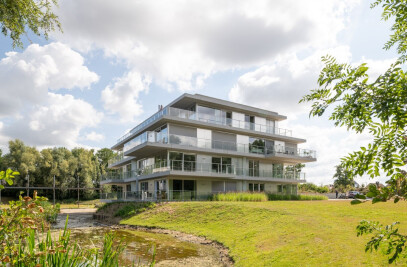‘A la Croisée des Chemins’ is the result of a unique and forward-looking educational project. The kindergarten and primary school are integrated into a green oasis within a dense urban fabric and are completely conceived as a school for active pedagogy.
The ambitions in terms of architectural quality, sustainability, economy, and the implementation of the programme were particularly high. The school was given an open, urban look and is city, child, and futureproof thanks to the sophisticated design focusing on the natural use of materials and respect for the environment. Green roofs were constructed wherever possible, while the façades are formed by volumes in wood. The pedestal is clad in architectural concrete which is a robust and durable material that shields the children from the urban environment. The sophisticated exterior design invites people to discover and develop their talents.
The design is a response to the city of Brussels’ innovative project to introduce an ‘active pedagogy’. This system proposes a different spatial organisation and an alternative circulation plan. The classroom model with the teacher standing at the front of the class has been relegated to the archives. This projectputsthechildcentral.
The school becomes a part of the neighbourhood by allowing the athletics complex to function separately. The three pillars of sustainability are very deliberately present throughout the building. We aimed for a minimal use of materials (ecology), good social innovation (a new style of class organisation), compact use of space (economic building), and high-quality architecture.
The design team opted for technical installations that allow for rational water and energy consumption. The impact of the building on the environment and on the health of the users has been kept to a minimum. It complies with all acoustics and humidity requirements and emphasises both waste management and valorisation of the natural environment. The design takes the flexibility and possible future functions for the building into account.
The classrooms are L-shaped and pieced together around the communal space like a puzzle. The wide corridors also serve as learning and play areas and allow the different age groups to interact with each other. The use of materials and colours for the interior was adapted to the age and the specific environment. The focus is on a proactive group approach rather than the reproduction of knowledge.
Every detail contributes to an inspiring environment that stimulates the senses and helps individuals develop their talents. The different areas are adapted to the age groups. The organisation, the circulation, the typologies of the classrooms, and the materials considered for each space separately and adapted to the individual needs.
Material Used:
1. Heradesign (sealings) – Albintra
2. Airdeck (lightweight concrete floors)
3. Armstrong (linoleum)
4. De Coene (Acoustic&firedoors)
5. Woodlam (Glue-laminatedwood)
6. Knauf (drywalls)
7. Bosan (sportsinstallation)
8. Zumtobel (lightning system)
9. Systemair (ventilation systems)
10. Honeywell (building management system)
11. Remeha (heating systems)

































